Quick start: this FAQ answers the common questions people ask about activity, exercise, and glucose management in type 1 diabetes — using practical rules you can test in real life.
🎧 Prefer audio first? Listen to the full conversation here:
👉 Episode 18 — Exercise without fear: the Before–During–After playbook with Prof. Othmar Moser
Prepared by John Pemberton & Prof. Othmar Moser
With thanks (alphabetical): Dr Peter Adolfsson, Francesca Anna RD, Prof Rob Andrews, Dr Cat Russon, Dr Carmel Smart, Prof Mike Riddell, Dr Dessi Zaharieva — plus many others.
Disclaimer: this FAQ is for informational purposes only. It does not replace medical advice. Always consult your healthcare professional before making therapy changes.
Introduction
Living with type 1 diabetes means learning how different kinds of movement affect glucose. Not all movement is the same. In this FAQ we separate activity from exercise, explain why both matter, and lay out practical steps to manage glucose more safely and more predictably.
If you want the full Exercise system and the linked guides, start here: Exercise & Type 1 Diabetes — Practical Guide. If you want the dedicated Activity guide, start here: Activity (Exercise Snacks) — Practical Guide.
Part 1: Activity vs exercise
Q: What’s the difference between activity and exercise?
- Activity = everyday movement (walking, cycling to the shop, gardening, playing with your kids).
- Exercise = structured training (running, lifting weights, team sports, endurance sessions).
Think of activity as a glucose and health tool, and exercise as fitness and performance training.
See the Activity guide: Activity (Exercise Snacks) — Practical Guide
Q: Why does the distinction matter?
- Activity: lower hypoglycaemia risk, immediate glucose benefits, achievable for almost everyone.
- Exercise: higher hypoglycaemia risk, needs planning (Before–During–After), but brings fitness and performance benefits.
Both matter. The skill is choosing the right tool for the right job — and not treating every movement like it needs a full exercise protocol.
Part 2: Activity FAQs
Activity summary (PDF): Physical Activity and T1D FAQ

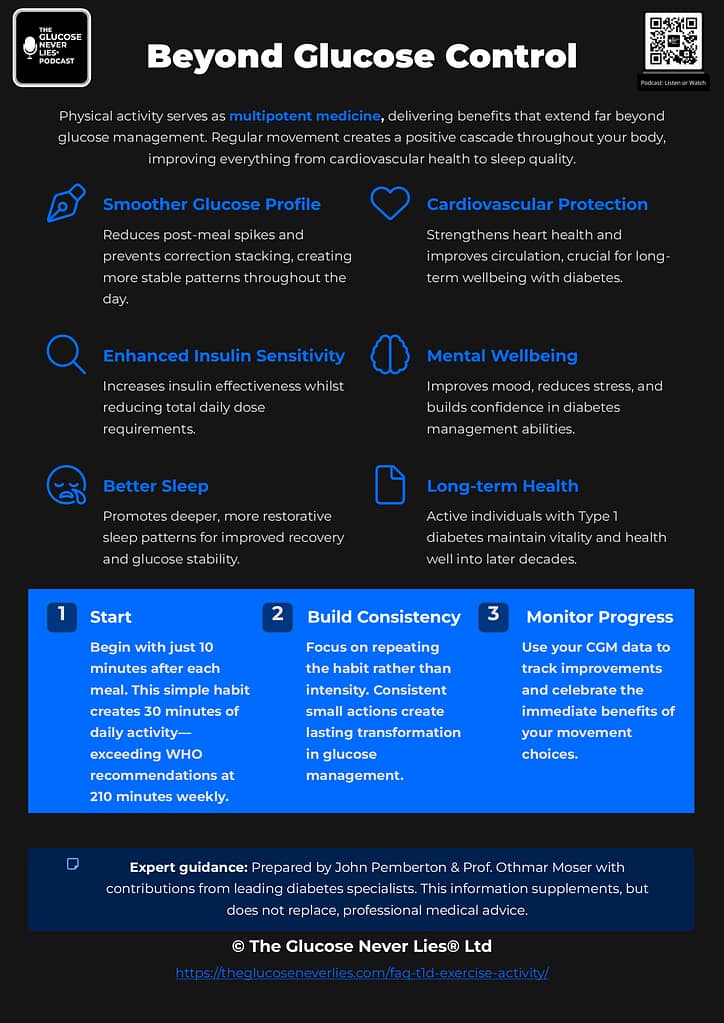
Q: Why focus on 10 minutes of activity after meals?
A short 10-minute walk after eating is a practical lever that works for most people:
- It can lower the post-meal glucose peak.
- It can speed up insulin action (so the insulin you already took works better).
- It builds confidence that movement is safe and useful.
This sits in the broader idea that small movement doses can be more repeatable (and more sustainable) than heroic exercise plans.
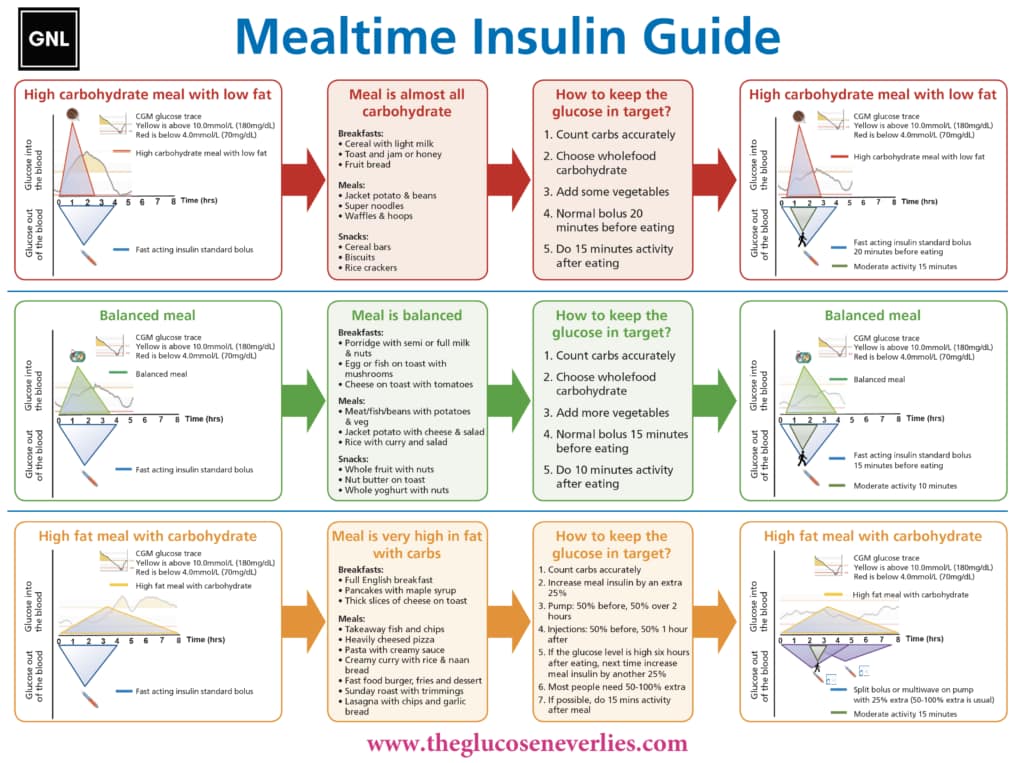
See the Activity guide: Activity (Exercise Snacks) — Practical Guide
Q: What if my glucose is high — above 10 mmol/L (180 mg/dL)?
If you have eaten in the last ~4 hours and have insulin on board, light activity can sometimes lower glucose safely without stacking correction doses.
- 20 minutes of light activity can lower glucose by roughly ~2 mmol/L (~40 mg/dL) for some people.
- Avoid exercise if ketones are elevated (and follow your sick-day rules).
- Think of this as a tool — not a punishment and not a replacement for insulin when insulin is needed.
See: Activity Snacking (20 by 2) and download: 20 by 2 and 20 by 40.
Or as Grace would say: “99 problems, but high ain’t one.” (download and share widely)
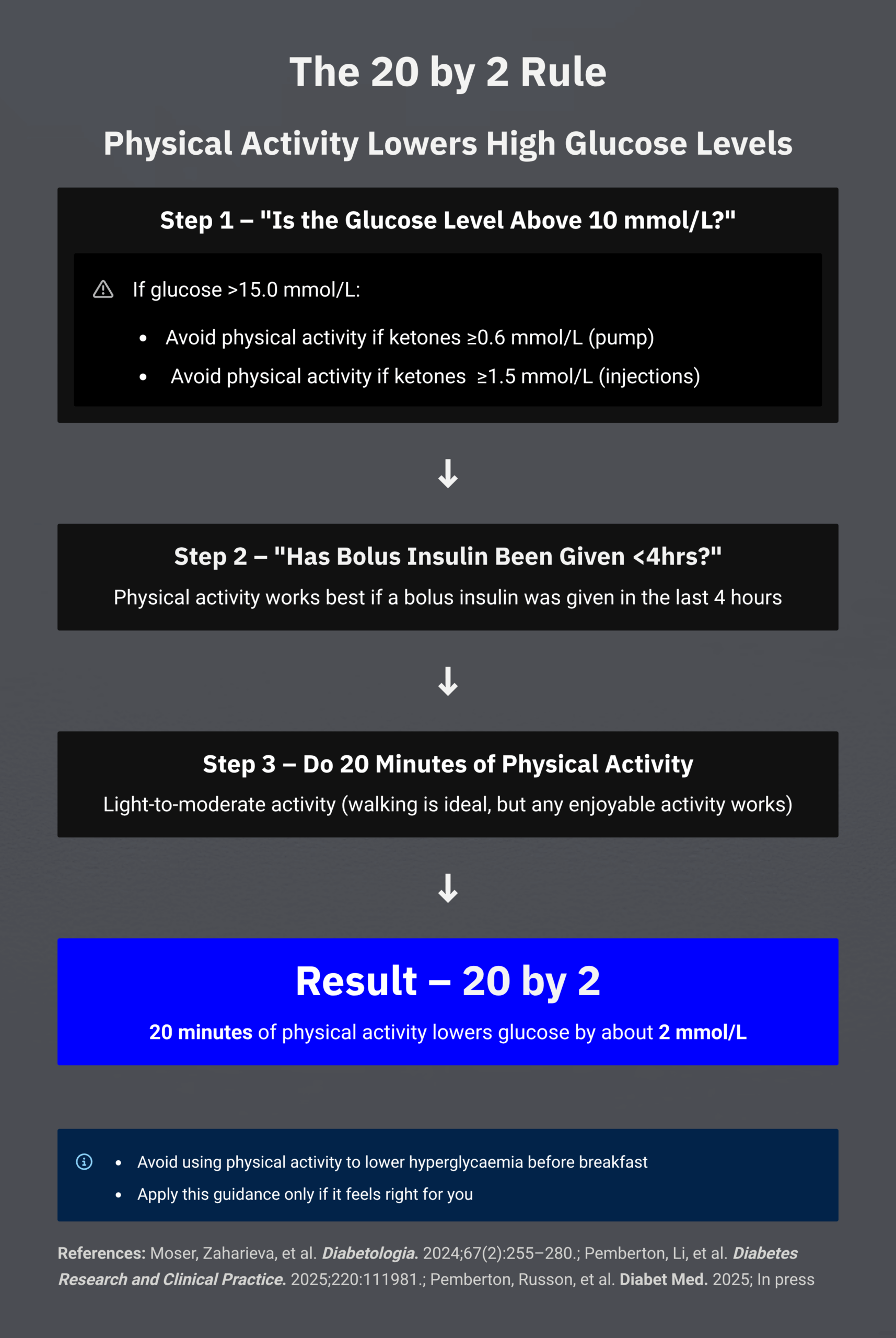
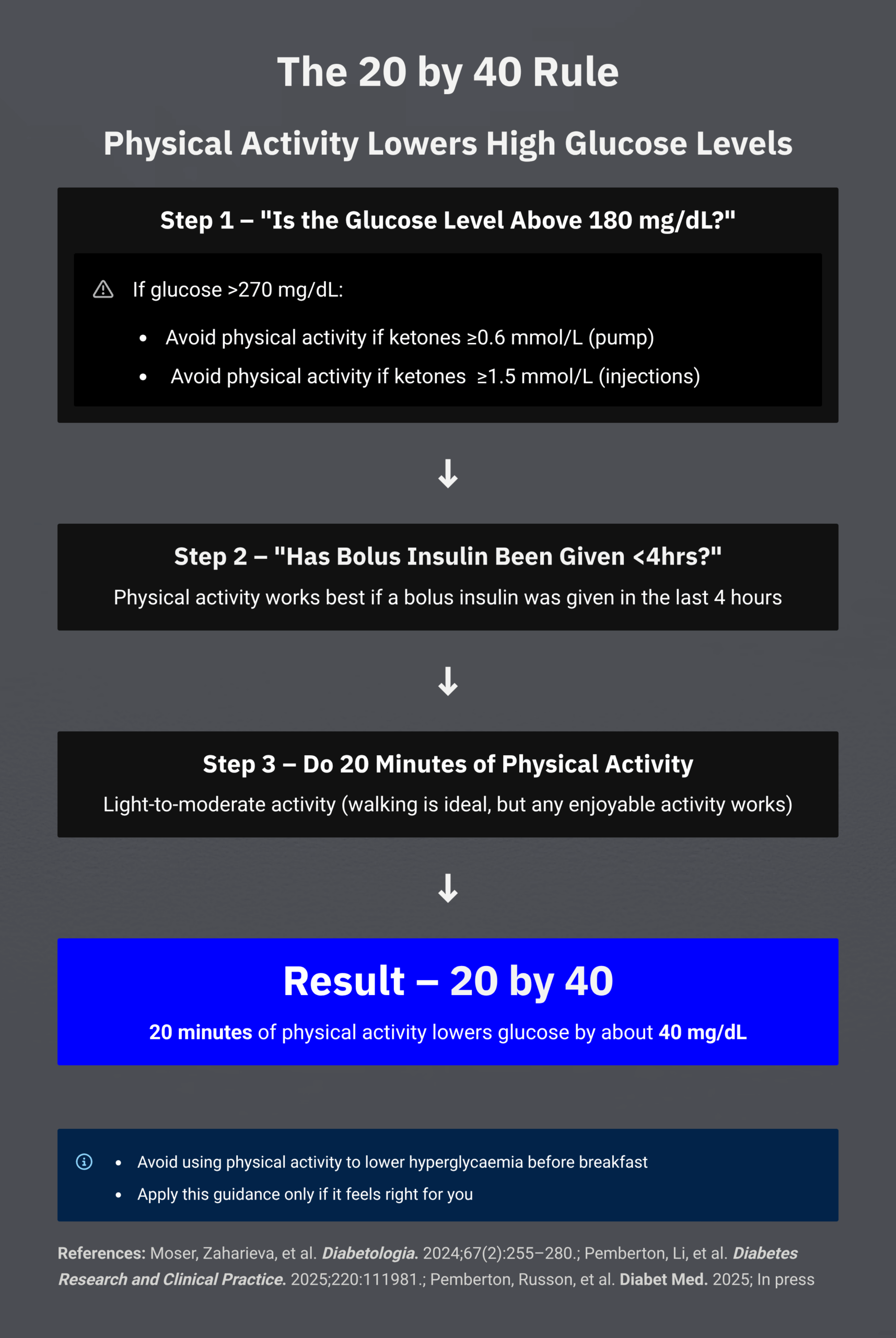
Q: How does CGM help with activity?
CGM provides real-time biofeedback. It makes the benefits of activity visible:
- Flatter post-meal peaks after a short walk.
- Clearer cause-and-effect (especially useful for children and families).
- Motivation: people see that movement changes glucose now, not “in theory”.
See: CGM Series
Part 3: Exercise FAQs
Q: What’s the main risk with structured exercise?
Hypoglycaemia is the main risk. For most people, large drops during exercise are not “random”. They are usually a predictable consequence of too much insulin on board for the session.
If you only remember one rule, remember this: major in the majors — insulin on board first, then starting glucose, then trend arrows. Exercise type comes after.
See the Exercise system hub: Exercise & Type 1 Diabetes — Practical Guide
Q: How do I plan exercise safely?
Use a Before – During – After framework. This is not about perfection — it is about making safe starting plans and then learning from outcomes.
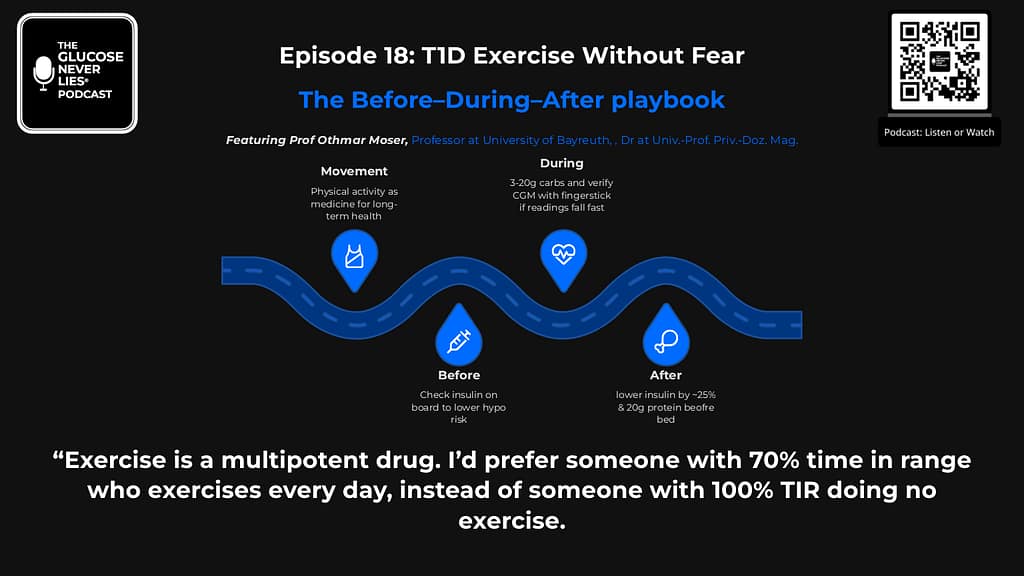
Before exercise
- Start with the main driver: insulin on board.
- If you can, aim for the Three-Hour Rule: last significant bolus >3 hours before exercise.
- If you need to eat within ~2 hours of exercise, aim to eat within ~1 hour and reduce the bolus (often 25–50% as a starting point).
- If on an AID system: set exercise mode / temp target 1–2 hours before when possible.
- If on pump therapy: consider reducing basal 50–80% 1–2 hours before (and learn what works for you).
During exercise
- Common target starting range: 7–10 mmol/L (126–180 mg/dL) (individualise with your team).
- Check glucose every 20–30 minutes and make decisions using value + trend arrows.
- Supplement carbs early and in small amounts (often 3–20 g depending on trends and intensity).
- CGM is excellent, but if symptoms do not match the sensor — or if you are dropping fast — confirm with a fingerstick (CGM can lag).
- Aim to stay in a safe working range rather than chasing a perfect line.
After exercise
- Common risk window: the first 1–2 hours after exercise, especially after longer sessions.
- For some people, a second risk window can occur overnight (often early morning), particularly after evening exercise.
- AID systems: consider leaving exercise mode/temp target on for 1–2 hours after, then reassess.
- Pump therapy: consider continuing a basal reduction for ~2 hours, then reassess.
- MDI: if eating, consider reducing bolus 25–50% as a starting point and review the outcome.
- Some people find a small protein-based snack before bed helps stability after evening sessions — treat this as an experiment, not a rule.
Summary: Exercise and T1D FAQ (PDF)
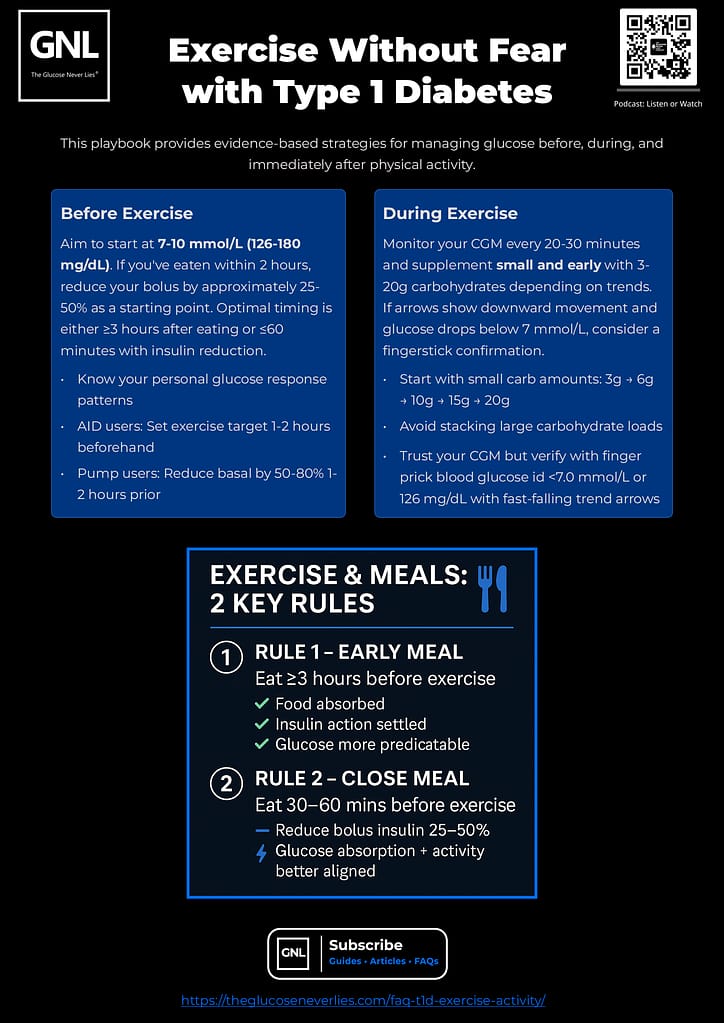
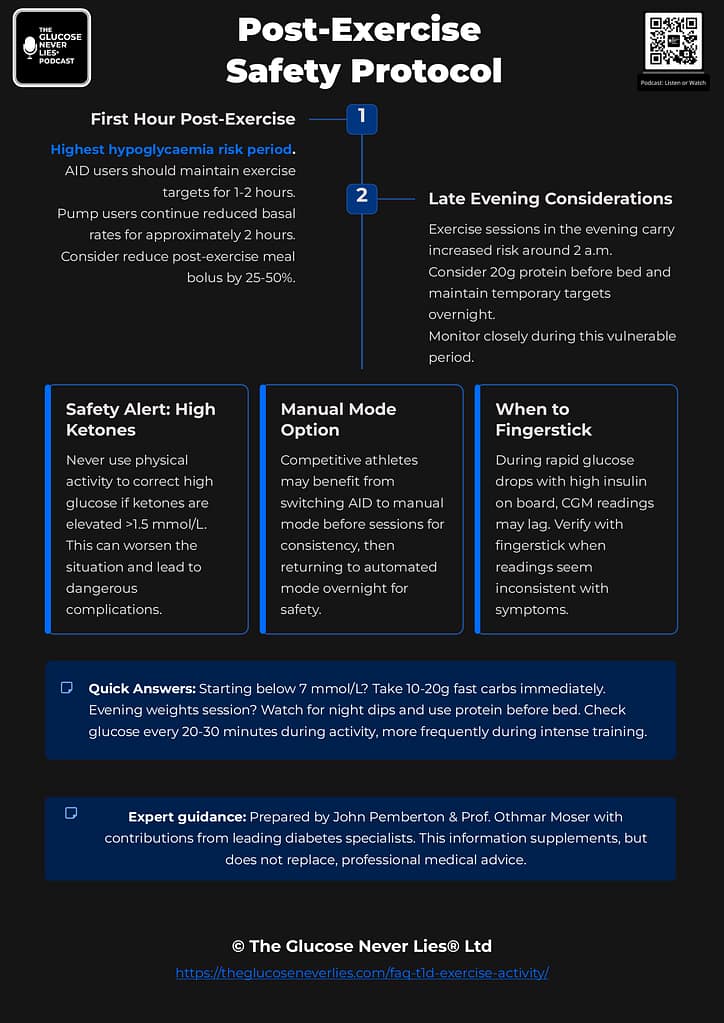
Part 4: Benefits of activity overall
Q: Why prioritise activity if I already exercise?
Because activity brings unique benefits beyond formal training:
- Glucose control: smooths post-meal peaks and reduces the need for corrections.
- Insulin sensitivity: can lower total daily insulin needs over time.
- Cardiovascular protection: regular movement is profoundly protective over the long term.
- Mental health: reduces stress and improves mood and confidence.
- Longevity: staying active is one of the clearest predictors of healthy ageing.
Exercise is a powerful tool. Activity is the tool you can deploy every day without needing perfect conditions.
See the Activity guide: Activity (Exercise Snacks) — Practical Guide
Final word
The goal is not perfect exercise glucose. The goal is safe, repeatable plans that get better over time.
- Activity: low risk, high reward, almost everyone can do it today.
- Exercise: higher risk, high upside — plan it using Before–During–After.
Start here if you want the full Exercise system: Exercise & Type 1 Diabetes — Practical Guide
Start here if you want the Activity system: Activity (Exercise Snacks) — Practical Guide

